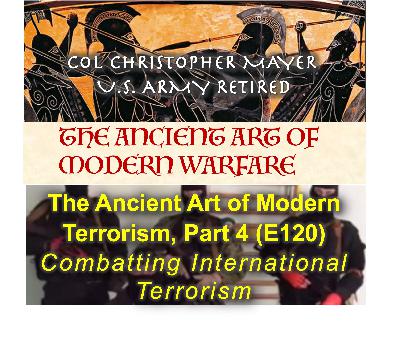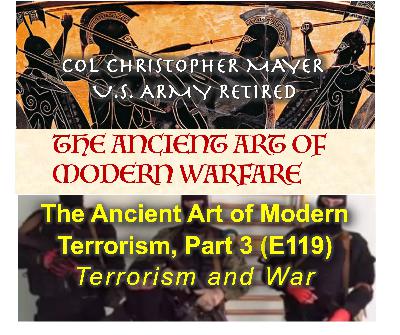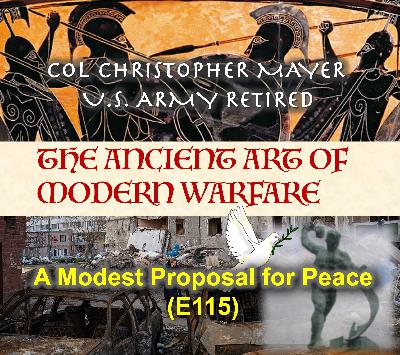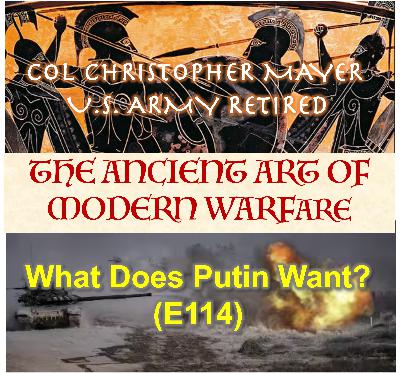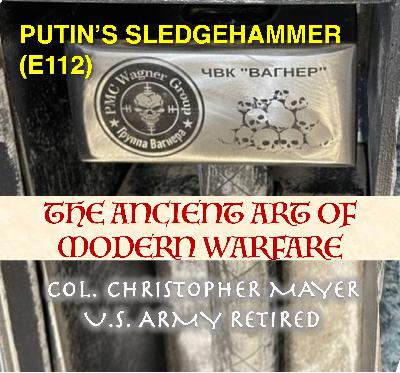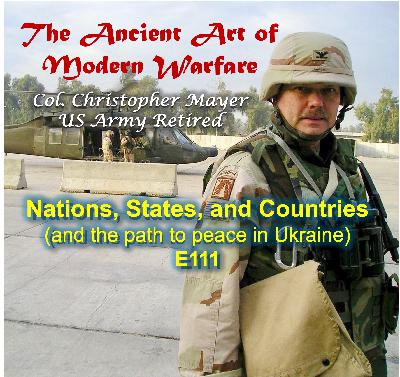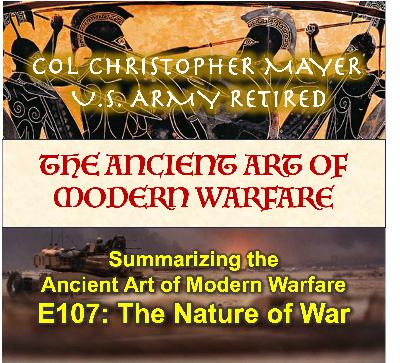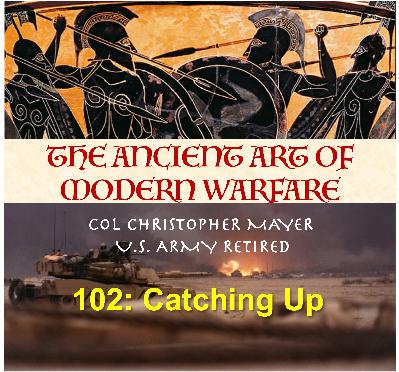Discover The Ancient Art of Modern Warfare
The Ancient Art of Modern Warfare

The Ancient Art of Modern Warfare
Author: Chris Mayer National Security and Strategy Consultant
Subscribed: 120Played: 2,162Subscribe
Share
© Copyright 2019 All rights reserved.
Description
Exploring how the practice of war changes while the fundamental nature and principles of war are unchanging. Host is COL Chris Mayer, USA RET, former member of the Advance Warfighting Working Group and the U.S. Government's expert on Private Military Companies. Includes Strategy, Revolution in Military Affairs, Hybrid Warfare, Cyber warfare, mercenaries, PMSC, Laws and Customs of War
121 Episodes
Reverse
If terrorism, unlawfully attacking civilian targets to achieve a political outcome, is a modern war form, a different manner of armed conflict. When terrorist attacks are planned, organized, and operate from a foreign country, or otherwise use that country as a safe haven, what are the options of the attacked State in using military force to fight this new form of armed conflict? This episode of the Ancient Art of Modern Warfare looks at the authority and limitations of the war making powers of a state to do that. In this episode, I do not look at the right or wrong of any particular State or any particular operation. This episode only sets the context for the potential use of military force against international terrorist organizations.
The information in these podcasts is solely my own opinion and do not represent the position of the U.S. Department of Defense, or any other organization I am or have ever been associated with.
Certified 100% natural intelligence. No artificial intelligence was used in making this podcast.
Principal Reference:
Office of the General Counsel, Department of Defense, Department of Defense Law of War Manual (2023), https://media.defense.gov/2023/Jul/31/2003271432/-1/-1/0/DOD-LAW-OF-WAR-MANUAL-JUNE-2015-UPDATED-JULY%202023.PDF
Music:
Kiilstofte, P. Mercenaries, Machinamasound (Licensed)
Liszt, Les Preludes, perfomed by the USMC Band. Public Domain
I decided to change the trajectory of this series. Rather than continue with the history of terrorism, I am jumping ahead to how terrorism fits within the overarching philosophy of war. The manifestation of terrorism as it has evolved in the past century is not inconsistent with our understanding of war. Understanding that will help us to understand the ways and means to defeat it.
The information in these podcasts is solely my own opinion and do not represent the position of the U.S. Government, the Department of Defense, or any other organization I am or have ever been associated with.
References:
UN Office of Drugs and Crime, Introduction to International Terrorism, https://www.unodc.org/documents/e4j/18-04932_CT_Mod_01_ebook_FINALpdf.pdf
Office of the General Counsel, Department of Defense, Department of Defense Law of War Manual (2023), https://media.defense.gov/2023/Jul/31/2003271432/-1/-1/0/DOD-LAW-OF-WAR-MANUAL-JUNE-2015-UPDATED-JULY%202023.PDF
Music:
Kiilstofte, P. Mercenaries, Machinamasound (Licensed)
Liszt, Les Preludes, perfomed by the USMC Band. Public Domain
This continues my description of terrorism and warfare. The previous episode defined terrorism. This episode traces terroristic attacks from the Bible to the First World War and how it differed from modern terrorism. World War One had profound impacts on almost every aspects of human civilization and this included the use of terror to achieve political ends.
The information in these podcasts is solely my own opinion and do not represent the position of the U.S. Government, the Department of Defense, or any other organization I am or have ever been associated with.
References:
UN Office of Drugs and Crime, Introduction to International Terrorism, https://www.unodc.org/documents/e4j/18-04932_CT_Mod_01_ebook_FINALpdf.pdf
Office of the General Counsel, Department of Defense, Department of Defense Law of War Manual (2023), https://media.defense.gov/2023/Jul/31/2003271432/-1/-1/0/DOD-LAW-OF-WAR-MANUAL-JUNE-2015-UPDATED-JULY%202023.PDF
Music:
Kiilstofte, P. Mercenaries, Machinamasound (Licensed)
Liszt, Les Preludes, perfomed by the USMC Band. Public Domain
What is terrorism? Is it something as old as warfare or something that has changed the nature of war? Is fighting terrorism the same as counterinsurgency? Despite more than two decades of the so-called War on Terror, we seem no closer to ending terrorism that we were when the Black September group attacked the Olympic Village in 1972. Before we can propose solutions to a problem, we must start by defining the problem. According to Socrates, the first step in defining a problem is defining terms. Defining terrorism is the subject of this episode of the Ancient Art of Modern Warfare.
References:
UN Office of Drugs and Crime, Introduction to International Terrorism, https://www.unodc.org/documents/e4j/18-04932_CT_Mod_01_ebook_FINALpdf.pdf
Office of the General Counsel, Department of Defense, Department of Defense Law of War Manual (2023), https://media.defense.gov/2023/Jul/31/2003271432/-1/-1/0/DOD-LAW-OF-WAR-MANUAL-JUNE-2015-UPDATED-JULY%202023.PDF
Music:
Kiilstofte, P. Mercenaries, Machinamasound (Licensed)
Liszt, Les Preludes, perfomed by the USMC Band. Public Domain
I am reluctant to post much of anything about the current armed conflict in Gaza. As the saying goes, the first casualty in war is the truth, and the truth of this saying is manifest in Gaza. It is almost impossible to separate information from information operations by either side. The International Committee of the Red Cross cites allegations of grave beaches of the law of war by both sides. In previous episodes I described how war crimes make reaching peace even more difficult than it usually is. Nonetheless, if achieving peace seems insurmountable, a cease fire leading to non-kinetic conflict resolution may be possible if we listen and put pressure on each sides stated war aims.
These podcasts do not necessarily represent the views of the Department of Defense, the Army War College, or any other organization I am associated with
Music
Liszt, F. and Royal Philharmonic Orchestra, Totentanz, https://download.stream.publicradio.org/podcast/minnesota/classical/programs/free-downloads/2020/10/27/daily_download_20201027_128.mp3?listeningSessionID=0CD_382_200__6cca22efd3d270af449f392040641d0331631df3
Copland, A. & United States Marine Band. (2000) Fanfare for the Common Man, unpublished, Washington, DC. [Audio] Retrieved from the Library of Congress, (Fair use for educational purposes.)
Mozart, W.A. and Berlin Philharmonic Orchestra, Requiem in D Minor, downloaded from the Internet Archive, https://archive.org
Photo: Palestinian News & Information Agency. CC
It seems that the time has come in Putin’s war on Ukraine that both sides indicate a willingness to negotiate. But negotiate what? This episode moves on from what is necessary for a sustainable peace, what Putin’s real goals are in his war on Ukraine, and propose a possible path forward. I introduced this possible path in In Episode 104. This episode sets that idea in the context of the previous two episodes and the recent political and military developments.
Music:
Copland, A. & United States Marine Band. (2000) Fanfare for the Common Man, unpublished, Washington, DC. [Audio] Retrieved from the Library of Congress, (Fair use for educational purposes.)
Mozart, W.A. and Berlin Philharmonic Orchestra, Requiem in D Minor, downloaded from the Internet Archive, https://archive.org
Reference Book: Walsh, M. (2025). A rage to conquer: Twelve battles that changed the course of Western history (First edition). St. Martin’s Press.
Although diplomacy should not end when fighting begins, there are two conditions in war where one or more parties will seek to negotiate peace. One is when victory looks improbable, the other is when it looks certain. Which of these conditions is emerging in Ukraine? More importantly, which of these two conditions does Putin perceive as operative? In either condition, is negotiation leading to a sustainable peace realistic? Answering that question requires understanding what Putin really wants from his war, and what he will accept to get out of it.
Reference: Samuel Charap, Khrystyna Holynska, Russia’s War Aims in Ukraine, http://www.rand.org/t/RRA2061-6
Music: Holst, “The Planets: Mars Bringer of War,” downloaded from the Internet Archive https://archive.org/details/lp_holst-the-planets_gustav-holst-leopold-stokowski-los-angeles
Recently, Pope Leo XIV used the anniversary of the atomic bombing that ended WW2 to call for the rejection of war as a means to resolve conflicts. In ending war, or keeping war from breaking out, we must remember that war is a tool for resolving pre-existing conflicts. Ending war requires identifying and resolving those conflicts so that they do not become the seeds for future wars.
Music: Liszt, Les Preludes, US Marine Corp Band (Public Domain)
Putin’s Sledgehammer: The Wagner Group and Russia’s Collapse into Mercenary Chaos, by Professor Candace Rondeaux is a must read for anyone interested learning how Russia came to rely on mercenary-like organizations in its global strategy and how it has used them. This book is not just about Yevgeny Prigozhin and Wagner, not even about Russia's other quasi-mercenary actors. It is an excellent summary of how Russia has come to be what it is since the collapse of the Soviet Union. The opening section alone is worth the cover price of the book. This is an extensive who is who of Russian oligarchs, generals, and mercenaries. Putin’s Sledgehammer is not what one might consider a dry academic thesis. Professor Rondeaux tells this story better than any spy-thriller, better because it is true. Like most true stories, it seems more fantastical than any political fantasy. It tells why Russia intervened in Syria, Africa, Ukraine, and elsewhere, who are the players in developing that strategy, and how they implemented it. In shining the spotlight on Russia, the United States and the West in general is not let off the hook. The West did not simply stand aside while Russia pursued a global strategy through mercenary means. Western political leaders, however, made the mistake of thinking that Russia would turn away from its disruptive approach and accept the Western rules-based order if only given the proper incentives and sanctions. The West failed and continues to fail to understand Russia just as Russian leaders continue to misinterpret and misapply ways and means employed by the U.S. and its allies. In summary, Putin’s Sledgehammer is an outstanding single source for anyone interested in Russian imperial aspirations and the unconventional means it uses in pursuit of those goals.
References:
Rondeaux, C. (2025). Putin’s sledgehammer: The Wagner Group and Russia’s collapse into mercenary chaos (First edition). PublicAffairs.
The Ancient Art of Modern Warfare:
Episode 2: “What Are Russian Private Military Companies?” (2019)
Episode 4: “The Difference Between Russian Quasi-Mercenary Organizations and Western PMSCs” (2019)
Episode 6: “Meeting the Challenge” (2019)
Episodes 35-39: On Mercenary Warfare (2021)
Episode 54: “Russian Mercenaries” (2022)
Episode 63: “Why Wagner” (2023) (Which contains one guess that may have been true at the time, but was ultimately unreliable.)
Episode 75: “Wagner Decapitated?” (2023)
I am picking up my podcast series where I left off, addressing the challenges of peace. War is an act of violence among nations or states, affecting entire countries. These terms, nations, states, and countries are not synonymous. Confusing these terms leads to misunderstanding, misinterpretation, or can be used to create misperceptions. In this episode I try to clarify the difference among nations, states, and countries. Understanding the differences and relationships among these terms is important to analyzing the actual and claimed objectives of warring parties and to identify emotion driven propaganda that obstructs the path to peace.
The information in these podcasts represents only my own thoughts, and not those of any organization I am, or have ever been associated with. (Some of what I say may be completely opposed to official position of some of the organizations.)
Music:
Liszt, Les Preludes, perfomed by the USMC Band. Public Domain
Copland, A. & United States Marine Band. (2000) Fanfare for the Common Man. unpublished, Washington, DC. [Audio] Retrieved from the Library of Congress, (Fair use for educational purposes.)
Now that I have laid the groundwork for what I think everyone needs to know about war, I can digress and address current topics of interest, placing them in the framework of the Ancient Art of Modern Warfare. In this podcast I build on the topic of peace in the last episode to address current developments regarding Ukraine. Russia is the aggressor. Putin cannot be rewarded for his violations of international law, the laws and customs of war, both jus ad bellum and jus in bello, and threatening the peace and security of all of Europe. However, without a Western commitment to apply overwhelming force against Russian aggression, a cease fire is in order. The death and destruction of war without any serious prospects for victory violates Just War principles of proportionality and reasonable probability of success. Even Clausewitz would agree.
As usual, the opinions in these podcasts are my own and do not necessarily represent the opinion of the Department of Defense, anyone else in the U.S. Government, or any other organization I am or ever have been associated with.
Music: Wagner, R. and US Marine Corps Band, Siegfried’s Funeral March and Finale (Götterdammerung) from “Music of Richard Wagner” (1981) (Public Domain)
In my closing podcast summarizing the Ancient Art of Modern Warfare I review key points from Episodes 91-96 about peace, with an application to current events. When we are trying to figure out conflict termination the take-away should be that peace after war depends on:
Jus ad bellum and jus in bello. The material evils of war are only justified to correct an injustice so great that the continued harm of that injustice is worse than the harm caused by that war. The cure cannot be worse than the disease. Jus in bello limits those harms and makes the restoration of peace easier.
Being feared but not hated. This goes with Jus in Bello. Deliberate actions that cause unnecessary death and destruction, particularly to the civilian population and cultural/religious works, can inflame passion and hatred among the civilian population. The result can both extend the conflict and instill long-lasting resentments which plant the seeds of future war.
Jus post bellum: Establishing or re-establishing justice. Victory is not peace. It does not correct the injustices that justified the war. Victory, or the point where both sides are so exhausted that they accept a truce, is merely a necessary pre-condition for building a peace that addresses the root causes of the injustices that led to armed conflict.
Sadly, these are largely ideals, rarely practiced throughout history. They are derived from the numerous examples in the history of warfare which disregarded these concepts and the far fewer examples in which they were practiced, leading to a more sustainable peace.
Although this is the last episode covering the fundamentals that I think every citizen should know about war, the podcast will continue, but more on that next week.
Music: Copeland, A., and the US Marine Corps Band, Fanfare for the Common Man (2000), Library of Congress recording
After taking a Christmas break, I am picking up on my summaries of the Ancient Art of Modern Warfare. In the previous episode, I described the nature of war as violence intended to compel an opponent to submit to your will. Although this idea is described by Carl von Clausewitz in his magnum opus, On War, the Prussian philosopher of war is best known for the aphorism that war is a continuation of politics by other means. It is a catchy phrase, but that translation leaves a lot to be desired and misses key points Clausewitz wanted to make. As I see it, the key take-aways from this idea are:
War must be viewed as an instrument of national policy – one among many. War is not the policy; war is inserted to the ongoing political engagement to achieve the policy objective.
Therefore, it is important to know what that policy is – the objective the policy intends to achieve. That is, to understand what a nation intends to achieve by war, before embarking upon it.
It follows then, that the use of force in war must be consistent with the aims of that policy.
Not all wars have the policy objective of overthrowing the enemy.
A suspension of active warfare does not necessarily mean abandoning the strategic policy objective.
If you want to end a war, achieve or change the policy objective.
Reference: v. Clausewitz, C., On War, (Michael Howard and Peter Paret Ed. And Tansl.) © 1976 Princeton University Press, New Jersey, USA
Music:
Holst, G. The Planets: Mars, Bringer of War, Internet Archives, https://archive.org/details/GustavHolstThePlanetsMarsTheBringerOfWar_201709
Traditional, The Army Strings, Garryowen (Public Domain(
In this second episode of my summary series, I address the Nature of War. That nature is violence directed at an opponent to coerce him to submit to your will. This violence has always been the nature of war and it will always be so. Further, this violence must be so painful to your opponent that he will prefer submitting to your will rather than continuing to resist. How you apply that violence and where the pain must be applied changes with time, technology, and culture. Further, the tools to apply this pain are not just kinetic, or direct military action. Economic pain can be just as important as military force. So too is information directed towards increasing fear of pain in the opponents’ population, its leaders, and your opponents’ friends. What makes war different from other forms of violence is its political nature. This violence is directed towards achieving a political end state. Without directing military force to a clearly defined political objective military success is still possible but will, more than likely, end in strategic failure.
For more information refer to Episode 7 of this series, “What is War;” Episode 8: “The Natural Laws of War;” Episode 42: “All Successful Wars Are Alike;” and Episode 43: “Ways to Lose a War.”
Reference:
Clausewitz, C., On War, (Michael Howard and Peter Paret Ed. And Tansl.) © 1976 Princeton University Press, New Jersey, USA
Music:
Holst, G. The Planets: Mars, Bringer of War, Internet Archives, https://archive.org/details/GustavHolstThePlanetsMarsTheBringerOfWar_201709
Wagner, R. and USMC Band, Siegfried’s Funeral March, Public Domain
For a little more than five years and 105 episodes, I have been podcasting on what I believe everyone can and should know about war and sometimes more specifically the characteristics of the persistent conflict we see in the world around us. Almost every week, something develops that want to explain by placing it within the context of the enduring nature of war – and the pursuit of peace. That said, I think that I have just about said everything that needs to be said explaining what war is, how it is unchanging in nature, and how even the changing characteristics of war demonstrate war’s unchanging nature. In trying to respond to emerging events, this description was not laid out in any sort of logical framework. So, in the next few episodes I will try to summarize the key points, or takeaways, of the past hundred plus episodes, in a way that does provide that logical framework.
The opinions in these podcasts are my own and do not necessarily represent the opinion of the Department of Defense, anyone else in the U.S. Government, or any other organization I am or ever have been associated with.
Music:
Copland, A. & United States Marine Band. (2000) Fanfare for the Common Man. unpublished, Washington, DC. [Audio] Retrieved from the Library of Congress, (Fair use for educational purposes.)
The Army Strings, GarryOwen (Traditional) (Public Domain)
Kilstoffe, Jens, The Cavalry, Machinamasound (Licensed)
In a recent episode of my podcast series of “The Ancient Art of Modern Warfare” (E104) I described possibilities for an end to the fighting in Ukraine. Of course, any end to any armed conflict requires the agreement of both (or all) parties to the conflict. Russia’s invasion of Ukraine is no different. It is entirely possible, perhaps likely, that one party does not want an end to the fighting. The other party, on the other hand, is not willing to accept peace, or even an armistice that rewards an invasion of their nation. I do not have any answers. This short episode is an addendum to Episode 104 in which I bring up some issues I think we should consider before any armistice or peace proposal is rejected.
As usual, the opinions in these podcasts are my own and do not necessarily represent the opinion of the Department of Defense, anyone else in the U.S. Government, or any other organization I am or ever have been associated with.
Music: Wagner, R. and US Marine Corps Band, Siegfried’s Funeral March and Finale (Götterdammerung) from “Music of Richard Wagner” (1981) (Public Domain)
Last week, I attended the annual “Summit” meeting of the International Stability Operations Association, or #ISOA. This association includes 200 private corporations that support U.S. and friendly government engagement across the spectrum of stability, conflict, and post conflict operations. Presentations included speakers from the US Departments of Defense, State, Justice, Commerce, and USAID. Other speakers included representatives of the Ukrainian government, experts in cyber technology and artificial intelligence, and speakers representing companies currently providing private sector support in hostile environments, such as #Ukraine. The subject material was fascinating for what was said, and sometimes what was not said. A continuous stream of thought was why we were there. Why was it that these government agencies use private sector support in armed conflict, post-conflict, and disaster relief. That is the subject of this episode of the Ancient Art of Modern Warfare.
Disclaimer: The information in these podcasts is my own opinion and does not represent that of the Department of Defense, ISOA, or any other organization I am or have been affiliated with.
Reference: Kramer, F., The sixth domain: The role of the private sector in warfare, Atlantic Council (October 2024); https://www.atlanticcouncil.org/in-depth-research-reports/report/the-sixth-domain-the-role-of-the-private-sector-in-warfare/
Music:
Holst, G, The Planets, Mars Bringer of War Internet Archives, https://archive.org/details/GustavHolstThePlanetsMarsTheBringerOfWar_201709
Traditional, The Army Strings, Garryowen (Public Domain)
Kiilstofte, J., The Cavalry, Machinimasound (Licensed)
Is a negotiated peace possible, or even desirable between Russia and Ukraine? How can this be done without validating Russia’s invasion of Ukraine and encouragement of future aggression? These are critical questions to address as the incoming U.S. administration states that negotiating an end to that war and our involvement in it as one of its first priorities.
As usual, the opinions in these podcasts are my own and do not necessarily represent the opinion of the Department of Defense, anyone else in the U.S. Government, or any other organization I am or ever have been associated with. (Although, if the Advanced Warfighting Working Group was still in existence, I would probably have convinced the members to endorse this.)
PS: Apologies for the sound of my voice as I am recovering from something or other.
Music:
Copland, A. & United States Marine Band. (2000) Fanfare for the Common Man, unpublished, Washington, DC. [Audio] Retrieved from the Library of Congress, (Fair use for educational purposes.)
The Army Strings, GarryOwen (Traditional) (Public Domain)
Kiilstofte, P., Freedom Fighters, Machinimasound (Licensed)
We often hear that this or that military attack caused disproportionate civilian casualties. Most often, these accusations are directed against Israel, when they are not directed against the United States. I will be generous and presume that most of these accusations are based on a misconception of what proportionality in armed conflict means, and how it is different from proportionate use of force civil or human rights law circumstances. Proportionality in war is the subject of this episode of the Ancient Art of Modern Warfare.
Reference:
Although a main reference for almost all episodes is On War, by Carl von Clausewitz, a primary reference for this episode is Chapter 5.12 of the Department of Defense Law of War Manual, 2016 edition.
Music:
Holst, G. The Planets: Mars Bringer of War, downloaded from Internet Archive
Kilstoffe, Jens, The Cavalry, Machinamasound (Licensed)
What is the common theme to mercenaries, natural resources, hypersonic missiles, Gaza, and exploding pagers? I can think of several, but in a recent conversation with a colleague of mine, that common thread was challenges to the Law of War, or International Humanitarian Law. Can the notion of the law of war even survive in modern manifestations of armed conflict? I think it can, and it is just as important, if not more so, than in the mythical era of conventional war.
As usual, the views in these podcasts are my own and do not necessarily represent the views of the Department of Defense, any other organization, or any person I am or ever have been associated with.
Music:
Liszt, Les Preludes, the USMC Band. (Public Domain)
GarryOwen (Traditional), the Army Strings (Public Domain)


